White Quinoa vs Black Quinoa: What’s The Difference?
As a Certified Health Coach informing clients about healthy foods like quinoa is part of my job. Since white and black quinoa are two popular colors many of my clients ask how they’re different. Therefore, what’s the difference between white quinoa and black quinoa?
Black quinoa has a stronger, nuttier flavor, is crunchier and takes more time to cook than white quinoa. Black quinoa is colored black and retains its color when cooked. White quinoa is colored an off white and turns partly opaque when cooked. White quinoa is more common and easier to find.
This article will cover all the differences between the two starting with a side-by-side nutrient comparison. In addition, I’ll compare their textures, tastes, glycemic index, satiety index, prices and health benefits.
In addition to coaching clients about them, I’ve purchased, researched and consumed both prior to, during and after writing this article.
Nutritional Comparison: Are Both Healthy?
Both colors have similar nutritional profiles. The following table is a side-by-side comparison of the nutrients contained in 100-grams of each one.
To keep things as equal as possible, both are organic and from the same brand, Inca’s Gold.
| Black Quinoa (100 g) | White Quinoa (100 g) | |
| Calories | 378 | 376 |
| Protein | 15.6 g | 13.3 g |
| Carbohydrates | 71.1 g | 68.9 g |
| Fiber | 8.2 g | 7.1 g |
| Fat | 6.67 g | 5.56 g |
| Sugar | 0 g | 0 g |
| Vitamin A | 0 IU | 0 IU |
| Vitamin C | 0 mg | 0 mg |
| Iron | 4.8 mg | 6.0 mg |
| Calcium | 67 mg | 67 mg |
At first, it’s difficult to determine a real difference of nutrients between the two. This causes many people to ask, which is healthier?
White quinoa and black quinoa offer similar health benefits due to their similar nutrient profiles. Black quinoa provides a higher percentage of fiber and protein while white quinoa provides a higher percentage of iron. Both of them provide a similar number of calories, carbohydrates and calcium.
I include both colors as part of my nutrition plan. I consume the white variety more often due to their texture and more affordable price.
White Quinoa vs Black Quinoa: Which to Choose
Both are considered healthy, and you really can’t go wrong choosing either one. Some people will alternate between the two to avoid boredom. They even sell a tricolor version containing white, red and black.
Some people have different goals which may sway your decision. Let’s take a look at the most common ones.
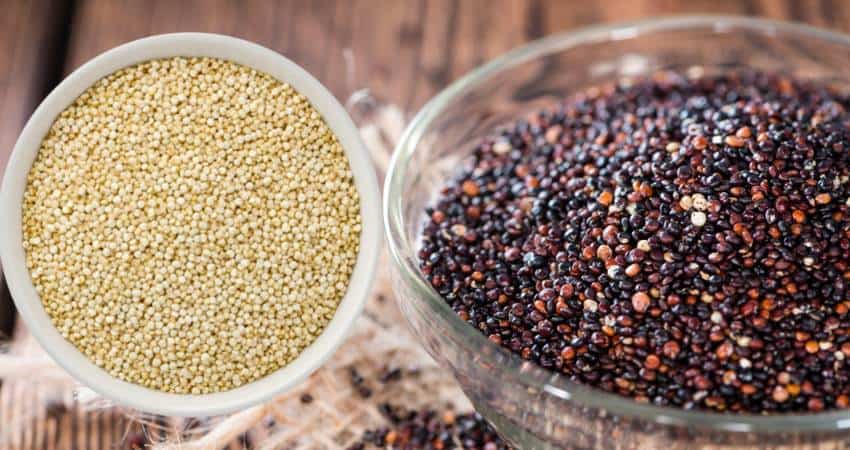
Weight Loss
The most popular goal may be weight loss. If you want to shed some extra pounds, you may ask, which one is better for weight loss?
White quinoa and black quinoa are similar for weight loss due to their similar number of calories per serving. White quinoa contains 169 calories per 1/4 cup dry. Black quinoa contains 170 calories per 1/4 cup dry.
The one calorie difference between the two isn’t large enough to make a difference when the goal is weight loss.
Including both of them as part of a well-balanced nutrition plan will help gain the maximum weight loss benefits.
Low-carb or Keto Diet
If your goal is a Keto or low-carb diet, then carbohydrates are your number one concern. If you’re on a low-carb diet, you may ask which has more carbohydrates?
Black quinoa compared to white quinoa is similar for a Keto or low-carb diet due to their similar amount of carbohydrates per serving. White quinoa contains 31 grams of carbohydrates per 1/4 cup dry. Black quinoa offers 32 grams of carbohydrates per 1/4 cup dry.
Another consideration for Keto diets is the amount of fat. Both are similar in the fat category also.
Bodybuilding
If your goal is to gain lean muscle mass, there’s a good chance you’re lifting weights in the gym or home. Which is better for bodybuilding?
Black or white quinoa are similar for bodybuilding due to their similar number of protein, carbohydrates and calories. White quinoa contains 5.98 grams of protein per 1/4 cup dry. Black quinoa contains 7.0 grams of protein per 1/4 dry.
The one-gram difference per serving between the two aren’t going to make a huge difference for building muscle.
Supplements for bodybuilding are expensive, and the costs add up pretty fast. Considering the price of both, black quinoa is more expensive and difficult to find.
The higher priced color which is also more difficult to find may sway your decision to white quinoa for bodybuilding.
For more details about the prices check out the price section below.
I often eat some during the morning on the days I train at the gym. The carbs help fuel my workout and I’m getting protein at the same time.
Gluten Free
White and black quinoa are naturally gluten free. In addition, both of them can be made into flour and used as a substitute for regular flour in gluten free recipes.
My Vitamix blender I use at home can make the flour, cashew, almond or any nut flour in seconds. Check out my blender review here, Vitamix Venturist V1220 Review.
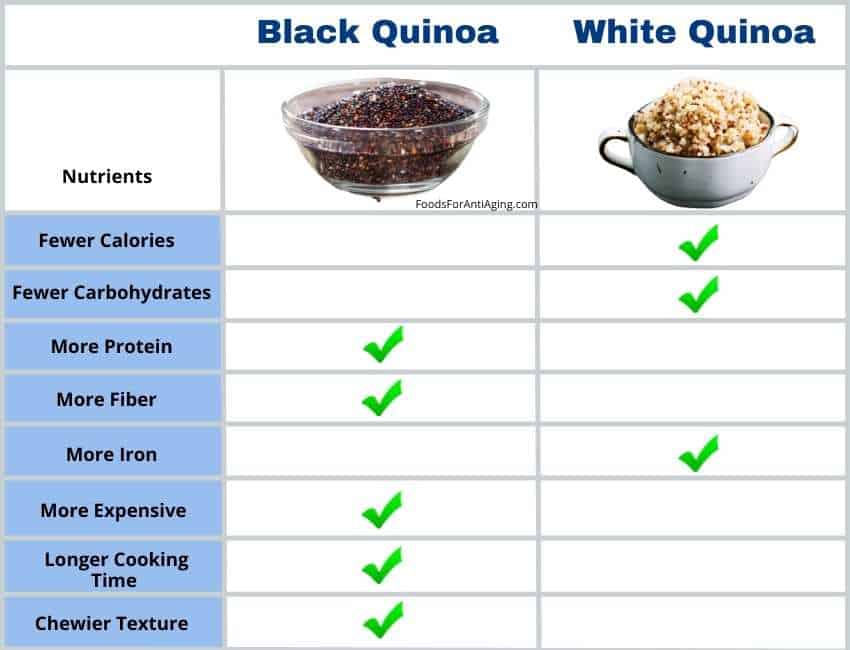
Price
It seems every day at the supermarket the price is higher than the last. The price of food certainly matters to most, especially with the rising costs of everything.
The price may sway your decision about which one to cook in your meals more often. Therefore, which color costs more?
Black quinoa costs more than white quinoa per serving. The average price for black quinoa is $15.49 per 1 pound bag. The average cost for white quinoa is $10.99 per 1 pound bag.
The prices for both foods vary depending on the store, location and sales offered. Therefore, to conduct original research, I searched various different stores to compare the price of both foods.
There didn’t seem to be a difference in price between white or tri-color in every store I checked. Therefore, you can get a mixture of black, red and white for the same price of white alone.
I first visited the Shoprite supermarket:
- Wholesome Pantry White Quinoa
- $3.99 per 12 oz bag (7 servings) equaling $0.57 per 1/4 cup serving
- Wholesome Pantry Tri-Color (White, Red, Black)
- $3.99 per 12 oz bag (7 servings) equaling $0.57 per 1/4 cup serving
I then checked Walmart:
- Food to Live White Quinoa
- $10.99 per 1 pound bag
- Food to Live Organic Black Quinoa
- $15.49 per 1 pound bag
I then checked Amazon for the prices:
- Bob’s Red Mill White Quinoa
- $8.49 per 13 oz bag (8 servings) equaling $1.06 per 1/4 cup serving
Taste and Texture
Many times, people choose to cook one food over the other because of its taste. Since there are some similarities between the two, many people wonder and ask, does each color taste the same?
White and black quinoa have a nutty and earthy flavor, but the black quinoa is nuttier and a bit sweeter. The main difference between the two is the texture. Although both are fluffy, the black quinoa is crunchier, chewier and less fluffy than white. If either one isn’t rinsed before cooking, they may taste bitter.
To conduct some original research and get the opinions of real people like you, I decided to poll my clients, readers and people in food groups I belong to. I asked them, which one do prefer the taste of?
- 63% said they preferred the taste of white quinoa.
- 34% said they preferred the taste of black quinoa.
- 3% said they had no preference.
To conduct more research I thought it would be fun to setup and participate in a blind taste test at home. I cooked each food and served it in a bowl with the same exact seasonings. All four of us chose the white variety. The main reason was the texture.
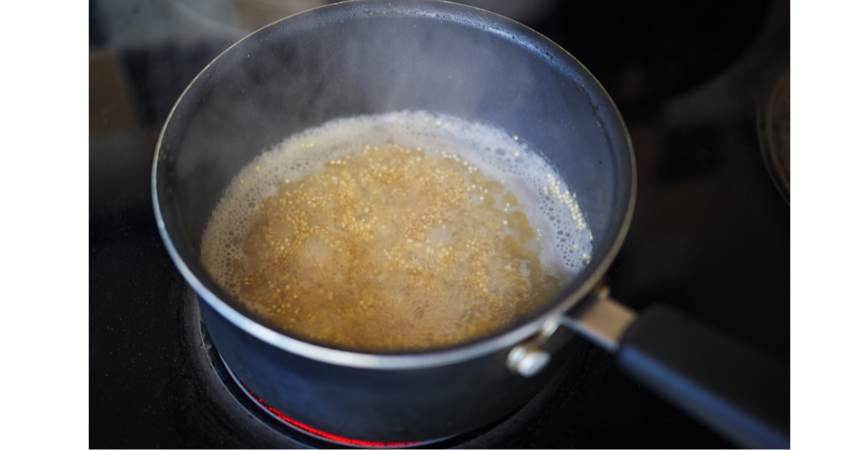
Cooking Differences for Recipes
How to Cook Quinoa
Most store bought is pre-rinsed, if it is not pre-rinsed it should be rinsed to avoid a bitter taste.
- In a pot combine 1 cup with 2 cups of water or broth.
- Bring to a rolling boil.
- Reduce heat, cover and simmer until liquid is evaporated (about 20-25 minutes for black, 10-15 minutes for white).
- Let stand 5 minutes then fluff with a fork and serve.
- Salt or add spices to taste.
Cooking tips:
- Black quinoa takes longer to cook.
- It is done when the liquid is absorbed.
- If it’s properly cooked, you can see little, curled ends.
- 1 cup of dry makes about 3 1/2 to 4 cups cooked.
- It should be cooked and not eaten raw.
- For finicky kids, consider adding small amounts to cookies, salads, meatballs or even macaroni and cheese.
Directions to cook can be found on the package. Also, some websites selling the product, give instruction, like IGA directions, which give extra directions for seasoning and preparation.
Substituting White and Black Quinoa
When someone can’t find one of the two foods to cook in a recipe, a common question asked is, can I substitute one for the other?
White and black quinoa are interchangeable with each other in recipes, side dishes, salads and baking. Black quinoa is better off in salads because it holds its texture better but is not as good for baked goods. Substitute one for the other using equal amounts called for in the recipe.
The video below informs you how to cook three easy quinoa recipes.
Glycemic Index
The glycemic index of food is important especially if blood sugar levels are a concern. Avoiding blood sugar spikes is an important part of consuming healthy food. This is true for diabetics or anyone worrying about their health3.
The Glycemic Index (GI) is a scale measuring how fast a particular food raises the blood sugar in the blood4. Blood sugar spikes can lead to health complications with the heart, nerves, kidneys and eyes5.
Foods on the GI scale are categorized as:
- Low-GI foods: 55 or under
- Medium-GI foods: 56-69
- High-GI foods: 70 or over
How blood sugars levels are affected:
- Foods with a glycemic index 70 or more cause a quicker spike in blood sugar levels.
- Foods with a glycemic index 56 to 69 cause a moderate spike in blood sugar levels.
- Foods with a glycemic index 55 or less cause a slow spike in blood sugar levels.
Having more knowledge of the glycemic index of food and how it raises blood sugar, many people ask, which one has a higher glycemic index?
Black quinoa has a higher glycemic index than white quinoa although both are considered low-GI foods.
Black and white quinoa cooked in boiling water for 15 minutes has a glycemic index of 54 and 50.
Glycemic loads are 24 for black and 23 for white.
Find out how oatmeal compared in my article. Which one is better?

Satiety Index
Satiety is a term used to explain the feeling of being full and the loss of appetite which occurs after eating food. The satiety index is a scale showing how full a person feels after eating a certain food.
The satiety index was developed in 1995 from a study which tested 38 foods. The foods were ranked how they satisfied a person’s hunger. Foods scoring under 100 are considered less filling and foods scoring above 100 are considered more filling ((National Center for Biotechnology Information: A satiety index of common foods)).
The table below shows the satiety scores of some grains, oats, rice and a few other filling foods.
| Food | Satiety Index Score |
| White bread | 100% |
| Brown rice | 132% |
| White rice | 138% |
| Lentils | 133% |
| Wholemeal Bread | 157% |
| Brown pasta | 188% |
| Oatmeal w/milk | 209% |
Unfortunately, quinoa was not one of the 38 foods tested. A study in 2005, by the University of Milan, tested the satiety of quinoa, buckwheat and oats compared to eating rice. All three had a higher satiating efficiency than rice6.
The study, or any other study I was able to find about satiety, didn’t reference whether the color tested. Since rice has satiety scores of 132% and 138%, we may be able to assume quinoa has a higher satiety score than 138%.
High satiety foods are likely to have a high score for the following reasons:
- High in protein.
- High in fiber.
- High in volume (foods containing a lot of water or air).
- Low in energy density (foods low in calories for their weight).
Both colors seem to fit into all four categories.
Find out how quinoa red compared to white in my article.
Health Benefits of White Quinoa and Black Quinoa
The nutrients in both are similar just in different percentages. Therefore, the benefits contained in both are similar. The following describes how each nutrient may benefit health and which food provides the greater percentage.
In the following video a doctor informs you about quinoa and its health benefits.
Protein
Both colors are good sources of protein. Protein may help benefit the following:
- Boost metabolism
- Reduce appetite
- Build and repair muscle
- Weight loss
Find out how lentils compared in my article.
Fiber
Both are high in soluble fiber, which is helpful for many reasons7. What makes fiber soluble is it dissolves in water.
Soluble fiber is known for the following:
- Helps avoid constipation and have a more regular stool.
- Help overall digestive health.
- Aids greatly in weight management because it allows you to feel full faster and eat less.
- Decrease the risk of diabetes by managing the blood glucose levels.
B Vitamins
The B vitamins provided include the following:
- B1 (thiamin)
- B2 (riboflavin)
- B3 (niacin)
- B5
- B6
- B9 (folate)
B vitamins help support the following:
- Nerve function.
- Energy levels.
- Digestion.
- Brain function.
- Cardiovascular disease.
- Red blood cells.
A lack of B vitamins has been associated with oxidative stress and neural inflammation. In a study released in 2018 32 healthy adults were given B vitamin supplementation for six months. The results indicated preliminary evidence B vitamin supplementation reduced oxidative stress and inflammation8.
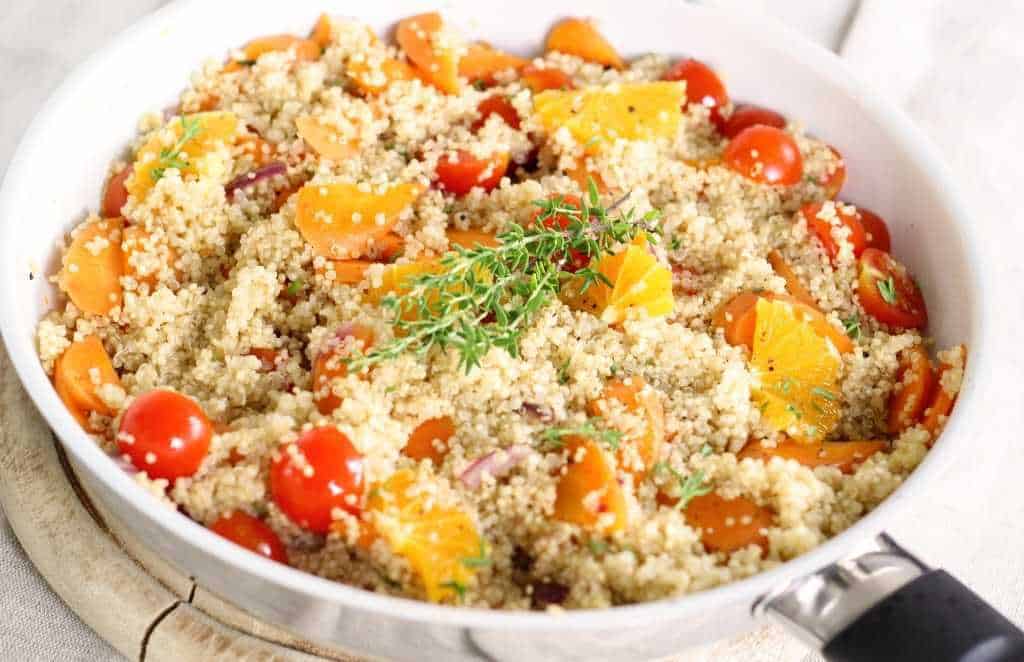
Calcium
Calcium is important for the heart and blood pressure. Harvard Health reports calcium helps maintain blood pressure by helping in the controlling of the relaxing and tightening of blood vessels9.
Calcium also helps the following:
- Help the muscles to function properly.
- Helps nerve function.
- Build and maintain strong bones.
Magnesium
Magnesium helps keep blood pressure levels stable and balanced. Recent scientific research examined previous studies and concluded magnesium supplementation decreased systolic and diastolic blood pressure10.
Magnesium helps control the following:
- Nerve function
- Blood pressure
- Muscle
- Insomnia
- Blood sugar
One reason many people supplement with magnesium in the evening is because it helps calm the whole-body including blood vessels.
In the heart and muscles, magnesium competes with calcium to help the muscles relax after contracting. When the body is low in magnesium, calcium can over stimulate the heart muscle’s cells causing a rapid or irregular heartbeat ((National Institutes of Health: Magnesium)).
Find out how millet compared in my article, Millet vs Quinoa: Which is Better? A Complete Comparison.
Potassium
Potassium helps the body get rid of excess sodium reducing fluid build-up. These helps keep systolic and diastolic blood pressure lower11.
According to Harvard Health, a number of studies have shown a connection between low potassium levels and high blood pressure12. The more potassium, the more sodium your body will lose.
Consuming too much sodium or not enough potassium throws off the delicate balance the kidneys need to remove the excess water13.
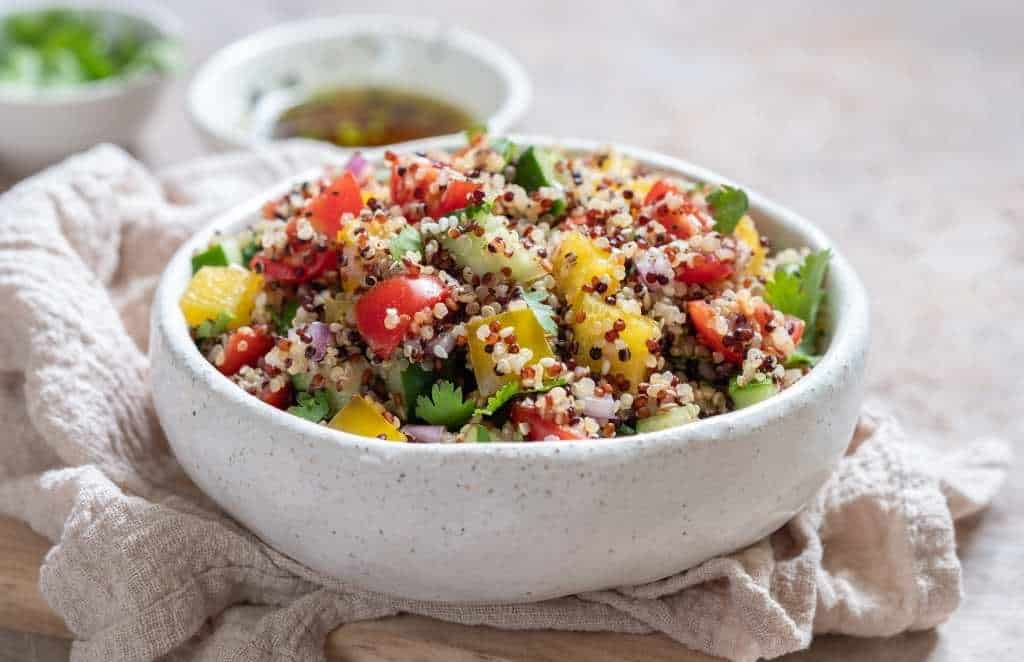
Phosphorus
Phosphorus has been shown in scientific studies to help with the following:
- Muscle recovery and contraction.
- Help the body store and manage energy.
- Help the kidneys remove waste.
- Promote healthy nerve conduction.
- Promote teeth and bone strength.
Iron
Either one is an excellent choice if you need to get your daily value of iron. Iron is essential in the creation of red blood cells and is a necessary part of any healthy diet.
Iron is also vital for growth and development, as some hormones need iron to be appropriately balanced.
Find out how bulgur compared in my article, Bulgur vs Quinoa: Which is Better? A Complete Comparison.
If you have any questions about this article don’t hesitate to email us. You can find an email on our contact page.
Read Next – More Food vs Food Articles!
Brown Rice vs Quinoa: Which is Better? A Complete Comparison
Couscous vs Quinoa: Which is Better? A Complete Comparison
Barley vs Quinoa: Which is Better? A Complete Comparison
Organic Lentils vs. Conventional Lentils: Which is Better?
Brown Rice vs White Rice: Which is Better for Bodybuilding?
- USDA: Organic White Quinoa [↩]
- USDA: Organic Black Quinoa, Black [↩]
- The University of Sydney: Your GI Shopping Guide [↩]
- Harvard Health Publishing: Glycemic index for 60+ foods [↩]
- National Institute of Diabetes and Digestive and Kidney Diseases: Know Your Blood Sugar Numbers: Use Them to Manage Your Diabetes [↩]
- Pub Med: Effect on appetite control of minor cereal and pseudo cereal products [↩]
- National Center for Biotechnology Information: Mechanisms linking dietary fiber, gut microbiota and colon cancer prevention [↩]
- National Center for Biotechnology Information: The Effect of a High-Dose Vitamin B Multivitamin Supplement on the Relationship between Brain Metabolism and Blood Biomarkers of Oxidative Stress: A Randomized Control Trial [↩]
- Harvard Health: Key minerals to help control blood pressure [↩]
- National Center for Biotechnology Information: Effect of magnesium supplementation on blood pressure: a meta-analysis [↩]
- American Heart Association: How Potassium Can Help Control High Blood Pressure [↩]
- Harvard Health: Potassium lowers blood pressure [↩]
- National Center for Biotechnology Information: The Effect of the Sodium to Potassium Ratio on Hypertension Prevalence: A Propensity Score Matching Approach [↩]
